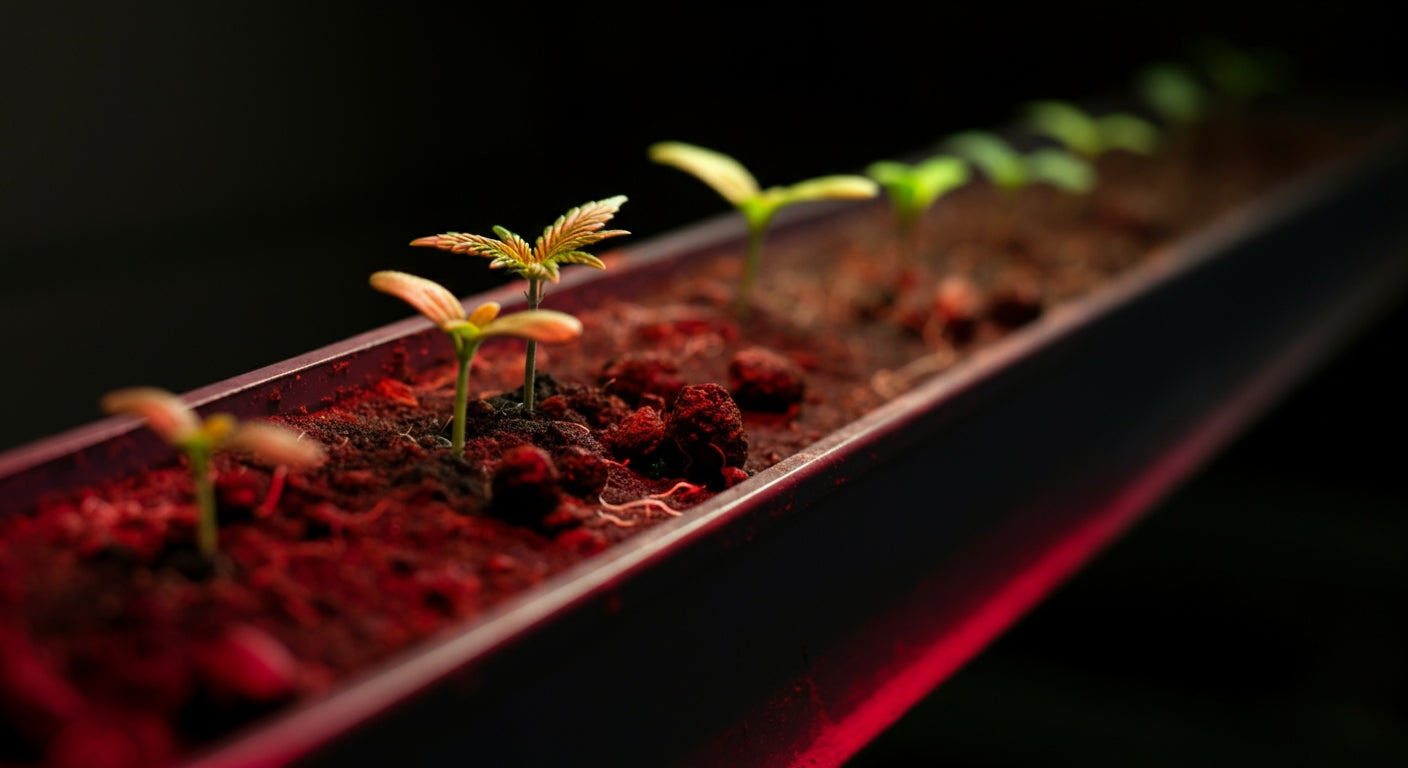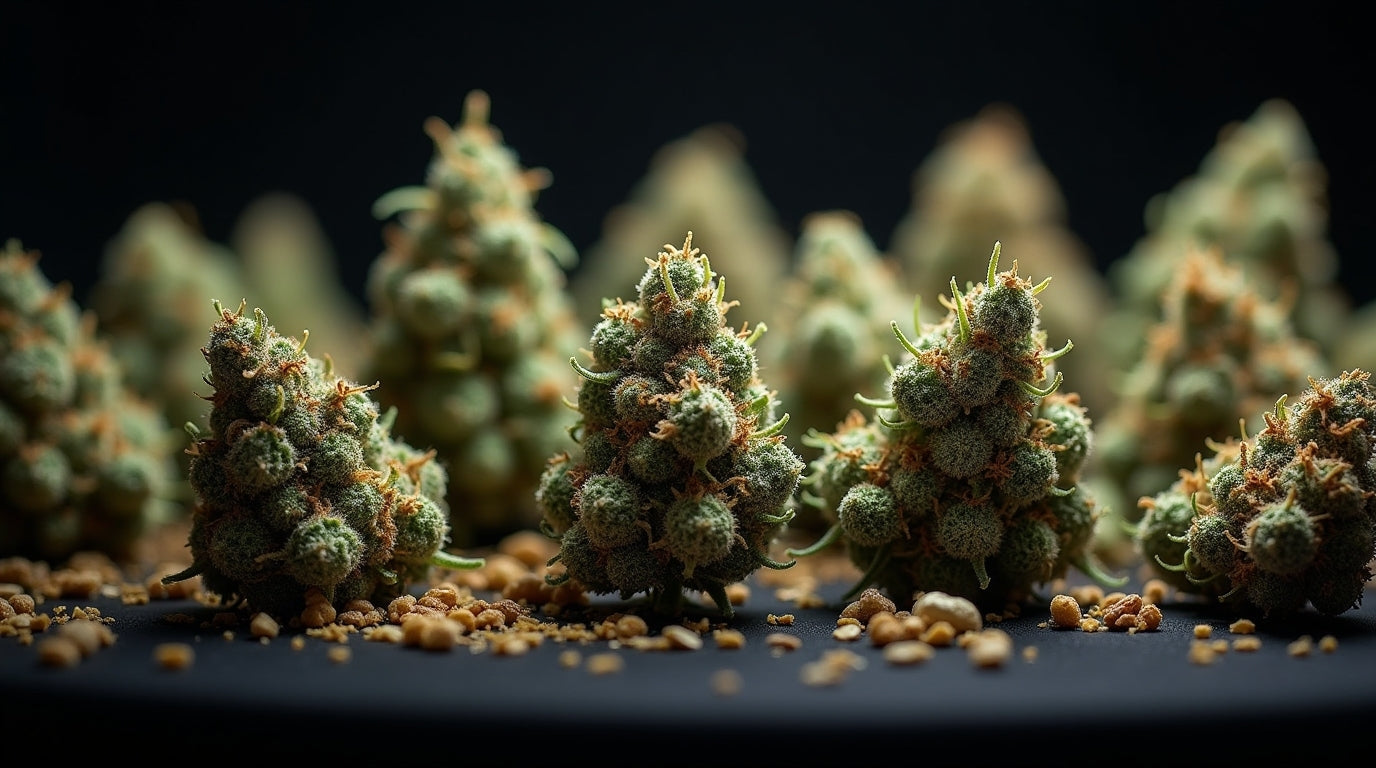
How Long Does It Take Weed to Grow: Your Complete Cannabis Timeline Guide
The question "how long does it take weed to grow" is one of the most common inquiries from new cannabis cultivators. The answer depends on several factors, but most cannabis plants require 3-6 months from seed to harvest, with specific timelines varying based on growing method, strain genetics, and environmental conditions.
Understanding cannabis growth timelines helps you plan harvests, optimize growing schedules, and set realistic expectations for your cultivation journey. Whether you're growing for personal use or considering commercial cultivation, mastering timing fundamentals ensures consistently successful harvests.
Quick Answer: Indoor cannabis typically takes 14-20 weeks total (3-5 months), while outdoor grows may take 4-8 months depending on climate and strain selection.
Cannabis Growth Stages and Timeline Breakdown
Complete Growth Cycle Overview
Cannabis plants progress through four distinct growth stages, each requiring specific timeframes and environmental conditions:
Germination: 3-10 days Seedling Stage: 2-3 weeks
Vegetative Stage: 3-16 weeks (controllable indoors) Flowering Stage: 6-12 weeks (strain dependent)
This timeline represents photoperiod strains grown indoors where growers control environmental conditions. Outdoor grows follow natural seasonal patterns, while autoflowering varieties operate on fixed genetic timelines regardless of light cycles.

Stage 1: Germination (3-10 Days)
Germination marks the beginning of your cannabis timeline. Proper seed germination techniques significantly impact both success rates and overall growing timelines.
Factors Affecting Germination Speed:
- Seed Quality: Fresh, viable seeds germinate within 24-72 hours
- Temperature: Optimal range of 70-85°F (21-29°C) speeds germination
- Moisture: Consistent humidity without waterlogging prevents delays
- Method Used: Paper towel method often fastest, direct soil planting more variable
Timeline Optimization: Using quality seeds and maintaining optimal conditions typically results in 3-5 day germination periods. Poor conditions or old seeds may extend this to 7-10 days or result in germination failure.
Stage 2: Seedling Development (2-3 Weeks)
The seedling stage establishes your plant's foundation and sets the pace for future growth. During this period, plants develop their first true leaves and establish root systems.
Week 1: Cotyledon leaves emerge and begin photosynthesis Week 2: First serrated true leaves appear, growth accelerates Week 3: Multiple leaf sets develop, plants ready for vegetative stage
Environmental Impact on Seedling Timeline:
- Lighting: 18-24 hours of gentle lighting promotes fastest development
- Temperature: 75-80°F (24-27°C) maintains optimal growth rates
- Humidity: 65-75% supports healthy leaf development
- Nutrients: Light feeding prevents stunting without burning
Optimal seedling conditions can complete this stage in 14 days, while suboptimal environments may extend it to 21+ days.
Stage 3: Vegetative Growth (3-16 Weeks Variable)
The vegetative stage offers growers the most control over timeline, as plants remain in this phase until light cycles change (for photoperiod strains) or genetics dictate transition (autoflowers).
Indoor Vegetative Timeline Control
Indoor growers can maintain vegetative growth indefinitely by providing 18-24 hours of daily light. This flexibility allows timeline manipulation based on desired plant size and harvest timing.
Minimum Vegetative Period: 3-4 weeks for small plants Standard Indoor Vegetative: 6-8 weeks for medium plants
Extended Vegetative: 10-16 weeks for large plants or mother plants
Growth Rate Factors:
- Lighting Intensity: Higher PPFD levels increase growth rates
- Environmental Stability: Consistent conditions promote faster development
- Nutrition Program: Proper feeding schedules maximize growth potential
- Training Techniques: Plant training methods can extend vegetative time but increase yields
Optimizing Vegetative Growth Speed
Understanding VPD (Vapor Pressure Deficit) becomes crucial for maximizing vegetative growth rates. Proper VPD management ensures optimal transpiration and nutrient uptake, significantly impacting growth speed.
Optimal Vegetative Environment:
- Temperature: 75-85°F (24-29°C) during lights on
- Humidity: 55-70% relative humidity
- Light Cycle: 18-24 hours daily for photoperiod strains
- Nutrients: Higher nitrogen levels with complete micronutrient profiles
Using advanced LED grow lights with full-spectrum output can reduce vegetative time by 1-2 weeks compared to less efficient lighting systems.
Stage 4: Flowering Timeline (6-12 Weeks)
Flowering represents the final and most critical stage for timeline planning, as this period is largely dictated by genetics rather than environmental manipulation.
Indica vs. Sativa Flowering Times
Indica Strains: Typically flower for 6-9 weeks
- Faster finishing makes them ideal for quick turnarounds
- Dense, compact buds develop rapidly
- Better suited for limited growing seasons
Sativa Strains: Generally require 9-12+ weeks flowering
- Longer flowering periods but often higher yields
- More complex terpene profiles develop over extended periods
- Require more patience but often superior quality
Hybrid Strains: Usually 7-10 weeks depending on dominant genetics
- Balanced characteristics offer predictable timelines
- Most commercial strains fall into this category
Early vs. Late Harvest Timing
Early Harvest (Week 6-8):
- Higher THC levels with energetic effects
- Shorter total timeline but potentially reduced yields
- Clear to cloudy trichomes indicate readiness
Peak Harvest (Week 8-10):
- Optimal balance of potency and yield
- Cloudy trichomes with some amber development
- Maximum weight and quality for most strains
Late Harvest (Week 10-12+):
- More sedative effects as THC converts to CBN
- Fuller terpene development but declining THC
- Amber trichomes indicate overripeness approaching

Factors That Affect Cannabis Growing Speed
Environmental Conditions
Temperature Stability: Fluctuating temperatures slow growth and extend timelines. Maintaining proper grow tent environments ensures consistent development rates.
Lighting Quality and Intensity: Modern LED grow lights provide optimal spectrums that can reduce overall growing time by 1-3 weeks compared to inferior lighting systems.
Air Quality and Circulation: Proper ventilation prevents CO2 depletion and maintains optimal growing conditions that support maximum growth rates.
Nutrition and Plant Health
Nutrient Management: Proper feeding schedules prevent deficiency-related slowdowns that can extend growing timelines significantly.
Potassium Availability: Adequate potassium levels during flowering ensure proper bud development and prevent extended flowering periods.
Plant Health Maintenance: Pest or disease issues can extend timelines by weeks or months, making prevention crucial for meeting harvest deadlines.
Growing Method Impact on Timeline
Soil Growing: Generally 3-5 months total
- More forgiving for beginners
- Slower nutrient availability may extend vegetative periods
- Natural microbial activity supports steady growth
Hydroponic Systems: Often 2-4 months total
- Faster nutrient uptake accelerates all growth stages
- Deep Water Culture (DWC) can reduce total time by 2-4 weeks
- Requires more precise monitoring but offers speed advantages
Automated Growing Systems: Optimized timelines through consistent environmental control
- Eliminates human error that extends growing periods
- Maintains optimal conditions 24/7 for maximum growth rates
Autoflower vs. Photoperiod Timeline Differences
Autoflowering Cannabis Timeline
Autoflowers operate on fixed genetic timelines regardless of light cycles:
Total Timeline: 8-12 weeks from seed to harvest
- Germination: 3-7 days
- Vegetative: 2-4 weeks (automatic)
- Flowering: 5-8 weeks (automatic)
Advantages: Predictable timelines, multiple harvests per year, no light cycle management Disadvantages: No timeline control, generally smaller yields, limited training opportunities
Photoperiod Cannabis Timeline
Photoperiod strains require light cycle changes to trigger flowering:
Total Timeline: 14-28+ weeks (highly variable)
- Germination: 3-10 days
- Vegetative: 3-16+ weeks (grower controlled)
- Flowering: 6-12 weeks (genetics dependent)
Advantages: Complete timeline control, larger yields, extensive training possibilities Disadvantages: Longer minimum timelines, requires strict light management
Seasonal Growing Considerations
Indoor Growing Timeline Advantages
Indoor cultivation offers complete timeline control regardless of season:
Year-Round Growing: Multiple harvests possible with staggered planting Climate Independence: Optimal conditions maintained regardless of weather Harvest Planning: Schedule harvests for personal consumption or market demands
Complete grow tent setups provide everything necessary for controlled-environment growing, ensuring consistent timelines regardless of external conditions.
Outdoor Growing Season Constraints
Outdoor cultivation follows natural seasonal patterns:
Northern Climates: Single harvest typically ready September-October Southern Climates: Potential for two harvests with autoflowers or quick strains Greenhouse Growing: Extended seasons with environmental protection
Timeline Planning: Start indoor seedlings 2-4 weeks before outdoor transplanting to maximize growing seasons.
Speed Optimization Techniques
Environmental Optimization
CO2 Supplementation: Elevated CO2 levels (800-1200 PPM) can increase growth rates by 20-30%, reducing overall timeline by 1-3 weeks.
Perfect VPD Management: Proper vapor pressure deficit control optimizes transpiration and nutrient uptake for maximum growth rates.
Advanced Lighting: High-quality LED grow lights with optimal PPFD levels and spectrum ratios accelerate all growth stages.
Growing Technique Optimizations
Sea of Green (SOG): Shorter vegetative periods with multiple small plants can reduce total timeline while maintaining yields.
Screen of Green (SCROG): Trellis netting techniques maximize light exposure, potentially reducing flowering time needed for full development.
Hydroponic Advantages: Advanced hydroponic systems provide faster nutrient delivery, reducing vegetative time by 1-2 weeks.

Common Timeline Mistakes and Solutions
Rushing the Process
Harvesting Too Early: Results in reduced potency and yields. Use trichome examination rather than breeder timelines for harvest decisions.
Inadequate Vegetative Time: Small plants produce proportionally small yields. Allow adequate vegetative development for desired harvest size.
Environmental Shortcuts: Poor conditions extend timelines significantly. Invest in quality equipment for consistent results.
Timeline Planning Errors
Not Accounting for Drying/Curing: Add 4-8 weeks post-harvest for proper drying and curing to timeline calculations.
Seasonal Planning Mistakes: Outdoor growers must consider local frost dates and seasonal light changes when planning timelines.
Equipment Failures: Have backup systems for critical equipment to prevent timeline disruptions from equipment failures.
Strain-Specific Timeline Variations
Fast-Finishing Strains (Under 8 Weeks Flower)
Popular quick-finishing varieties:
- Northern Lights: 6-7 weeks flowering
- White Widow: 7-8 weeks flowering
- Critical Mass: 6-7 weeks flowering
These strains allow for faster turnarounds and multiple yearly harvests in indoor setups.
Long-Flowering Sativas (10+ Weeks)
Extended flowering varieties:
- Haze varieties: 10-14 weeks flowering
- Pure Sativas: 12-16+ weeks flowering
- Landrace strains: Variable but often extended periods
These strains require patience but often produce superior quality and unique effects.
Hybrid Balance (8-10 Weeks)
Most commercial strains fall into this category:
- OG Kush: 8-9 weeks flowering
- Blue Dream: 9-10 weeks flowering
- Gorilla Glue: 8-9 weeks flowering
Balanced characteristics make these ideal for most home growers.
FAQ Section
How long does it take to grow weed indoors from seed?
Indoor cannabis typically takes 14-20 weeks (3.5-5 months) from seed to harvest, including germination, seedling development, vegetative growth, and flowering stages. Complete grow tent kits help maintain optimal conditions for consistent timelines.
Can you speed up cannabis growing time?
Yes, several factors can reduce growing time: using hydroponic systems, maintaining optimal environmental conditions, providing adequate lighting, and choosing fast-finishing strains can reduce total time by 2-6 weeks.
How long does flowering stage take for most strains?
Most hybrid cannabis strains flower for 8-10 weeks. Indica-dominant varieties typically finish in 6-9 weeks, while sativa-dominant strains may require 9-12+ weeks for full maturation.
What's the difference between autoflower and photoperiod growing time?
Autoflowers complete their lifecycle in 8-12 weeks regardless of light cycles, while photoperiod strains take 14-28+ weeks but offer grower control over vegetative timing and final plant size.
How long does it take outdoor weed to grow?
Outdoor cannabis follows seasonal patterns, typically planted in spring (April-May) and harvested in fall (September-October), resulting in 4-6 month growing seasons depending on climate and strain selection.
Summary
Bottom Line: Cannabis growing time ranges from 8-12 weeks for autoflowers to 14-28+ weeks for photoperiod strains, with most indoor grows completing in 3-5 months from seed to harvest. Environmental optimization, quality genetics, and proper equipment significantly impact timeline consistency and success rates.
Understanding cannabis timelines helps growers plan harvests, optimize growing schedules, and set realistic expectations. While genetics ultimately determine flowering periods, environmental factors and growing methods substantially influence vegetative development and overall success.
Optimize Your Cannabis Growing Timeline Today
Achieve consistent, predictable cannabis growing timelines with professional equipment designed for optimal plant development. Gorilla Grow Tent provides everything necessary for controlled-environment cultivation that maximizes growth rates and ensures reliable harvest schedules.
Whether you prefer quick autoflower cycles or extended photoperiod cultivation, our equipment maintains optimal conditions throughout every growth stage. With advanced LED lighting, environmental controls, and lifetime growing support, you'll consistently meet timeline goals while maximizing yields and quality.
Don't leave your growing timeline to chance. Browse our complete selection of growing equipment and hydroponic systems to build the perfect setup for predictable, successful harvests every time. Join thousands of growers who trust Gorilla for consistent timeline performance and exceptional results, harvest after harvest.

Lena Myles
I'm a mushroom enthusiast and home cook based in Oregon. I'm passionate about foraging and creating fungi-focused recipes, especially delicious, plant-based dishes using gourmet mushrooms like trumpet, shiitake, and oyster. When I’m not in the kitchen, you’ll usually find me wandering the woods in search of new wild flavors.


